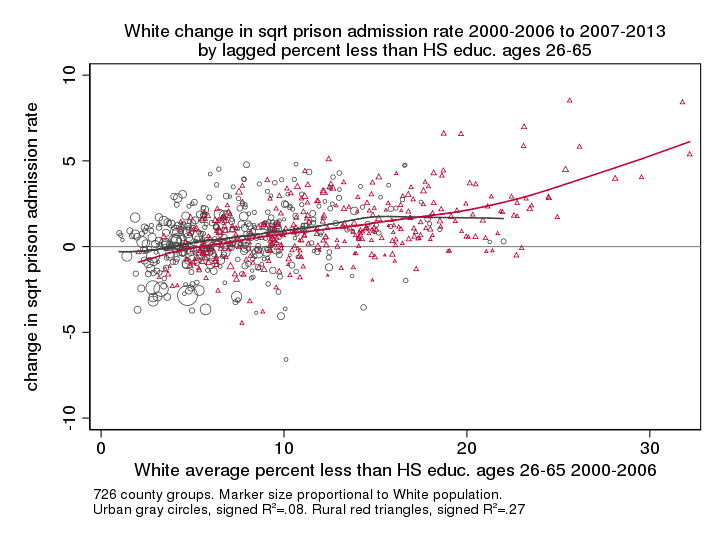I’ve just posted my working paper to SocArXiv that shows that high White rural imprisonment rates and rises in imprisonment rates in county groups are linked to poverty and low education in rural areas. The paper gathers up the graphs and analysis from my previous post and also provides regression analysis. There is a lot to do to explain these patterns, but the first step is documenting them. Links to the previous blog posts: 1) Documenting the trends in White & Black imprisonment rates by area type 2) Rates are related to education & poverty & racial composition 3) Changes in rates are related to education & poverty & racial composition of the area
Paper abstract:
The rise in White imprisonment in rural areas has gone almost completely unnoticed and undiscussed until very recently. Using data newly analyzed from the National Corrections Reporting Program restricted files for 2000-2013, this report documents the higher rates of prison admissions for Whites in rural areas and shows that these higher rates are tied to the higher rates of White poverty and lower White educational levels in rural areas. Further, places with less educated White people showed more growth in White imprisonment. Poverty and education explain the urban-rural difference in a statistical sense, but this does not mean that there is no rural-urban difference. Rather, the analysis points to the high concentration of White disadvantage in rural areas and smaller cities. The Black patterns are different: although rates of poverty and high school dropouts are higher in rural areas for Blacks, the correlations are weaker than for Whites and rural areas have lower Black imprisonment rates both before and after controls for education and poverty. Looking at changes in imprisonment rates between 2000-6 and 2007-11, both Black and White imprisonment rose in areas with higher high school dropout rates and lower Black percentages, but the effects of poverty and college graduation rates and percent Hispanic varied by race in multivariate models. Overall, the findings point to the importance both of disaggregating Black and White imprisonment rates and of recognizing that overall national trends obscure marked differences in the trends between places. They also point to concentrated White disadvantage in White rural areas as linked to rising White imprisonment rates. Further research is necessary to understand these trends.

